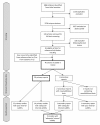The effectiveness of antenatal care programmes to reduce infant mortality and preterm birth in socially disadvantaged and vulnerable women in high-income countries: a systematic review
- PMID: 21314944
- PMCID: PMC3050773
- DOI: 10.1186/1471-2393-11-13
The effectiveness of antenatal care programmes to reduce infant mortality and preterm birth in socially disadvantaged and vulnerable women in high-income countries: a systematic review
Abstract
Background: Infant mortality has shown a steady decline in recent years but a marked socioeconomic gradient persists. Antenatal care is generally thought to be an effective method of improving pregnancy outcomes, but the effectiveness of specific antenatal care programmes as a means of reducing infant mortality in socioeconomically disadvantaged and vulnerable groups of women has not been rigorously evaluated.
Methods: We conducted a systematic review, focusing on evidence from high income countries, to evaluate the effectiveness of alternative models of organising or delivering antenatal care to disadvantaged and vulnerable groups of women vs. standard antenatal care. We searched Medline, Embase, Cinahl, PsychINFO, HMIC, CENTRAL, DARE, MIDIRS and a number of online resources to identify relevant randomised and observational studies. We assessed effects on infant mortality and its major medical causes (preterm birth, congenital anomalies and sudden infant death syndrome (SIDS)) RESULTS: We identified 36 distinct eligible studies covering a wide range of interventions, including group antenatal care, clinic-based augmented care, teenage clinics, prenatal substance abuse programmes, home visiting programmes, maternal care coordination and nutritional programmes. Fifteen studies had adequate internal validity: of these, only one was considered to demonstrate a beneficial effect on an outcome of interest. Six interventions were considered 'promising'.
Conclusions: There was insufficient evidence of adequate quality to recommend routine implementation of any of the programmes as a means of reducing infant mortality in disadvantaged/vulnerable women. Several interventions merit further more rigorous evaluation.
Figures
References
-
- World bank data catalogue. http://data.worldbank.org/data-catalog/world-development-indicators
-
- Norman PP, Gregory IP, Dorling DD, Baker AA. Geographical trends in infant mortality: England and Wales, 1970-2006. Health Statistics Quarterly. 2008;40:18–29. - PubMed
-
- Kurinczuk JJ, Hollowell J, Brocklehurst P, Gray G. Inequalities in infant mortality project briefing paper 1. Infant mortality: overview and context. Oxford: National Perinatal Epidemiology Unit; 2009. https://www.npeu.ox.ac.uk/files/downloads/infant-mortality/Infant-Mortal...
Publication types
MeSH terms
Grants and funding
LinkOut - more resources
Full Text Sources


